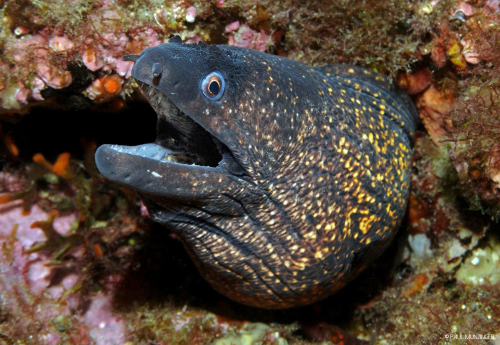Moray eels, conger eels, scorpionfish and octopuses.
Many of the species we see in the sea are predators, given that only a few of them that are herbivores and most of them feed on small invertebrates or plankton, which technically speaking makes them predators.
However, there are species that have specialised in the capture of other fish and molluscs. These are the hunters which we commonly understand as predators.

Our recommended dive: El Gat de Cap Norfeu- Cap de Creus
El Gat (The Cat) makes for a spectacular dive in Cap de Creus. The diving point is located at Cap Norfeu and has adopted this name based on the shape of some of the rocks which protrude above the surface that remind us of the silhouette of a cat.
Although we categorise it as a single dive, several routes can be made from the same starting point.
The route that we propose departs from a spot sheltered from the wind and the currents and descends to a zone of large rocks followed by a slope that reaches a flat section at around 20 to 24 metres deep and where a vertical wall begins where it reaches 50 metres in some places.
It not a very complex diving zone but it is necessary to keep an eye on the currents and our orientation. It is a dive which is suitable for all levels by adapting the depth to the level of the divers in any given group.
Throughout this initial diving zone, up to 20 to 24 metres, we can find a large number of great predators: moray and conger eels, octopuses and scorpionfish that seek shelter or food hidden amongst the holes in the rocks.
Besides the seahorses, we can find all sorts at El Gat: groupers, corals and gorgonians, schools of fish, and migratory fish. El Gat offers a complete immersion experience which, at the same time, allows us to discover multiple points of interest.
Remember that close attention must be shown, especially in the gorgonian areas. Regarding the large predators, all we need to do is show a respectful attitude as well as maintaining a safe distance to be able to observe them calmly.
